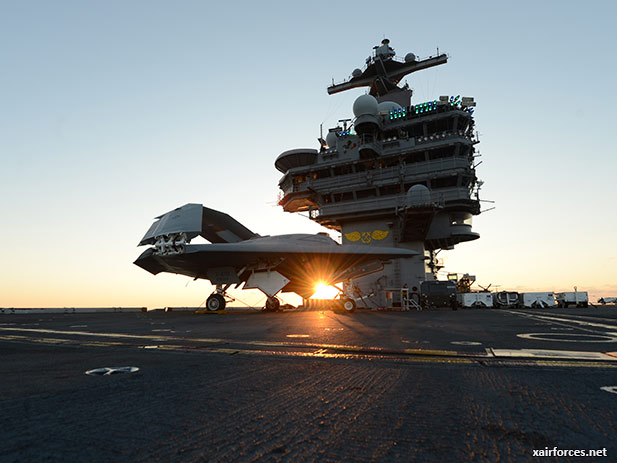
New X-47B Ship Goal: Clear Deck in 90 Sec.

U.S. Navy to test X-47B integration into carrier landing tempo as Uclass competition kicks off in summer.
The U.S. Navy is preparing to conduct a new round of sea trials this summer with its X-47B stealthy aircraft to prove the unmanned system can clear the busy aircraft carrier deck in 90 sec. or less, just like its piloted counterparts.
This would allow for a more seamless flow of manned and unmanned launches and recoveries on deck, a key step toward earning unmanned aircraft a coveted parking space on American carriers in 2020.
In parallel, the Navy plans to finally issue a formal request for proposals (RFP) for its X-47B follow-on, called the Unmanned Carrier-Launched Airborne Surveillance and Strike (Uclass) system. A draft is expected by the end of the third week of this month, with a final version coming out in the summer, kicking off a long-awaited competition between Lockheed Martin, Boeing, Northrop Grumman and General Atomics to build the first combat unmanned aircraft installed into the carrier air wing.
The X-47B Unmanned Combat Air System (UCAS) flight trials in midsummer are designed to prove “integration” of the aircraft into carrier air wing operations, meaning its takeoff, landing and ability to hold in a pattern could be sandwiched between traditional, manned platforms without disruption to the operations tempo. The threshold is to clear the deck 90 sec. after landing, but Navy X-47B program manager Capt. Beau Duarte says ideally the UCAS will do so in 60 sec.
Performance of the $1.8 billion program thus far prompted the Navy to add two more years of trials; it was slated to be shelved last summer.
Testing on the aircraft carrier USS Theodore Roosevelt will demonstrate a new automated wing-folding capability—today wing folding is manually commanded—and an automatic tailhook retractor. Both are needed to clear the deck hastily.
The X-47B has been to three different carriers already for testing in a “crawl, walk, run” demonstration strategy. “We are done crawling,” Duarte says.
The aircraft will also for the first time operate with a jet-blast deflector on the deck. This is critical to allow the X-47B to take off without disrupting operations behind the launch area.
Following the summer air wing integration tests, the program is requesting time on a carrier deck in 2015 for further integration testing. If no carrier is available, Duarte says he will instead focus on automated aerial-refueling testing of the X-47B. This requirement was sidelined earlier. Officials also are considering whether to test transiting through clouds as well as night deck handling and landing, although firm plans have not been set.
The Navy plans to field the first Uclass aircraft on a carrier deck in 2020, says Rear Adm. Mat Winter, the Navy program executive officer for unmanned aircraft and strike weapons.
The draft RFP is slated for release directly to competitors this month but will not be issued publicly, he says. Once a downselect to a single contractor occurs in the middle of fiscal 2015, about one year from now, more details are likely to be released. “What we have is a balance of classified information,” Winter says. “When knitted together, the sum of the parts provides insight that we need to wait until we go into contract award.”
A final RFP is expected by July, he says. Winter is confident the schedule to downselect will hold as much work as is being done now with the four contractors through their design review contracts. “This is a little more rigorous than traditional draft RFP review [process at the Pentagon],” Winter says. “A lot of what we are doing would normally happen after industry day.”
The goal is to field two simultaneous 24-hr./7-day-a-week orbits of Uclass capable of operating at a tactically relevant distance from the carrier, Winter says. He declined to identify the actual range-threshold requirement.
The Uclass mission primarily will be to collect intelligence, surveillance and reconnaissance data, though he says it must be capable of some “limited strike,” a factor not yet publicly defined.
The draft RFP will include some thresholds as well as objectives, all of which Winter declined to outline because of classification and source selection considerations. However, he says, the contractors will be required to identify “on-ramps” for their designs to extend capabilities of range and payload, for example. This would allow the Navy to bound its potential financial commitment to the program upfront, even if likely modifications are required later for an improved system.
“We want designs [that] bring you not only limited strike but that can afford to grow,” Winter says.
Duarte says he expects all four vendors to advance once the design review contracts are complete.
Source: By Amy Butler, Aviation Week & Space Technology News – 7 April 2014
Photo: An automated wing-folding capability will be added to the U.S. Navy to test X-47B Unmanned Combat Air System demonstrator aircraft, to allow for quicker taxiing and parking upon landing on a carrier deck. The U.S. Navy X-47B Unmanned Combat Air System demonstrator aircraft is lifted on an aircraft elevator aboard the aircraft carrier USS George H.W. Bush (CVN 77) May 14, 2013, in the Atlantic Ocean. The George H.W. Bush was the first aircraft carrier to successfully catapult-launch an unmanned aircraft from its flight deck in 14 May 2013. (Photo by defenseimagery.mil)
(7.04.2014)
|